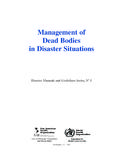Transcription of Disaster management guidelines - WHO
1 WHO/EHT/CPR 2005, formatted 2009 Best practice guidelines in Disaster situations 1 DDDIIISSSAAASSSTTTEEERRR MMMAAANNNAAAGGGEEEMMMEEENNNTTT GGGUUUIIIDDDEEELLLIIINNNEEESSS EMERGENCY SURGICAL CARE IN Disaster SITUATIONS These guidelines have been extracted from the WHO manual Surgical Care at the District Hospital (SCDH), which is a part of the WHO Integrated management on Emergency and Essential Surgical Care (IMEESC) tool kit. The following materials relevant to country's Disaster situation should be taken from the IMEESC tool.
2 Best practice protocols for Clinical Procedures Safety ( Disaster planning, trauma team responsibilities, hand hygiene, operating room, and anaesthesia check list, postoperative management , application of cast and splints, cardiac life support, airway management ), Needs assessment Essential Emergency Equipment List Details of anaesthesia, gunshot and landmine injuries in chapters 13, 14, 17 and 18, in SCDH List of Contents 1. Antibiotic Prophylaxis 2. Antibiotic Treatment 3. Tetanus Prophylaxis 4. Failure of Normal Methods of Sterilization 5.
3 Cleaning, Disinfection and Sterilization 6. Waste Disposal 7. Resuscitation 8. Unconsciousness 9. Wound management 10 . Hand Lacerations 11 . Specific Lacerations and Wounds 12 . Amputations 13 . Drains 14 . Insertion of Chest Drain and Underwater Seal Drainage 15 . Cellulites and Abscess 16. Op en F r actu r es 17. Upper Extremity injuries 18. Lower Extremity injuries 19. Spine injuries 20. Fractures in children 21. Compartment syndrome 22. Fat embolism syndrome 23. Female genital injury 24. Ketamine anesthesia 25. Postoperative care 26.
4 Essential Emergency Equipment Generic List 27. Anaesthetic Infrastructure/Supplies WHO/EHT/CPR 2005, formatted 2009 Best practice guidelines in Disaster situations 2 Antibiotic Prophylaxis Antibiotic prophylaxis is different from antibiotic treatment. Prophylaxis is intended to prevent infection or to decrease the potential for infection. It is not intended to prevent infection in situations of gross contamination. Consider using prophylaxis: - For traumatic wounds which may not require surgical intervention - When surgical intervention will be delayed for more than 6 hours.
5 Use therapeutic doses if infection is present or likely: Administer antibiotics prior to surgery, within the 2 hours before the skin is cut, so that tissue levels are adequate during the surgery More than one dose may be given if the procedure is long (>6 hours) or if there is significant blood loss. The use of topical antibiotics and washing wounds with antibiotic solutions are not recommended. Use antibiotic prophylaxis in cases where there are: 1. Biomechanical considerations that increase the risk of infection: - Implantation of a foreign body - Known valvular heart disease - Indwelling prosthesis 2.
6 Medical considerations that compromise the healing capacity or increase the infection risk: - Diabetes - Peripheral vascular disease - Possibility of gangrene or tetanus - Immunocompromised state 3. High-risk wounds or situations: - Penetrating wounds - Abdominal trauma - Compound fractures - Wounds with devitalized tissue - Lacerations greater than 5 cm or stellate lacerations - Contaminated wounds - High risk anatomical sites such as hand or foot - Biliary and bowel surgery. Use intravenous (IV) antibiotics for prophylaxis in clean surgical situations to reduce the risk of postoperative infection, since skin and instruments are never completely sterile.
7 For the prophylaxis of endocarditis in patients with known valvular heart disease: - Oral and upper respiratory procedures: give amoxicillin 3 g orally, 1 hour before surgery and g, 6 hours after first dose - Gastrointestinal and genitourinary procedures: give ampicillin 3 g, 1 hour before surgery and gentamicin mg/kg intramuscularly (IM) or IV (maximum dose 80 mg), 30 minutes before surgery. WHO/EHT/CPR 2005, formatted 2009 Best practice guidelines in Disaster situations 3 Antibiotic Treatment When a wound is extensive and more than 6 hours old, you should consider it to be colonized with bacteria, and use therapeutic doses and regimens.
8 Penicillin and metronidazole provide good coverage and are widely available. Monitor wound healing and infection regularly. Make use of culture and sensitivity findings if they are available. Continue therapeutic doses of antibiotics for 5 7 days. Tetanus Prophylaxis Active immunization with tetanus toxoid (TT) prevents tetanus and is given together with diphtheria vaccine (TD). Women should be immunized during pregnancy to prevent neonatal tetanus. Childhood immunization regimes include diphtheria, pertussis and tetanus.
9 Individuals who have not received three doses of tetanus toxoid are not considered immune and require immunization. A non-immune person with a minor wound can be immunized if the wound is tetanus prone; give both TT or TD and tetanus immune globulin (TIG). A non-immunized person will require repeat immunization at six weeks and at six months to complete the immunization series. Examples of tetanus prone wounds include: - Wounds contaminated with dirt or faeces - Puncture wounds - Burns - Frostbite - High velocity missile injuries.
10 Give prophylactic antibiotics in cases of wound contamination Immunize the non-immune patient against tetanus with tetanus toxoid and give immune globulin if the wound is tetanus prone. Tetanus prophylaxis regime Clean wounds Moderate risk High risk Immunized and booster within 5 years Nil Nil Nil Immunized and 5 10 years Nil TT or TD TT or TD since booster Immunized and >10 years TT or TD TT or TD TT or TD since booster Incomplete immunization











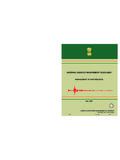
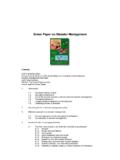
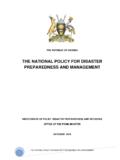
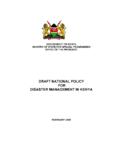

![Disaster Management Act [No. 57 of 2002]](/cache/preview/e/5/d/2/b/3/6/7/thumb-e5d2b36743b64ebe9204d7e874f734ad.jpg)
